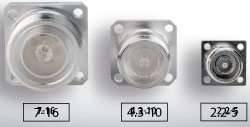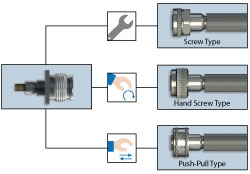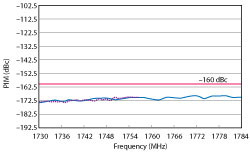
Modern mobile networks are becoming increasingly powerful. More and more data is being transferred faster and more reliably, because today’s mobile society has no tolerance for slow connections to the internet or the loss of voice, images or video. Everything has to travel fast and, indeed, everywhere—any service, anywhere, anytime. Taking advantage of any service, anywhere and anytime has become a matter of course. 5G will make applications possible only dreamed of a few years ago.
With more and more demanding services, the requirements on the networks that transfer all this data inevitably increase. Never has the bandwidth requirement been as great as it is today. MIMO antennas, small cell concepts and innovative distributed antenna systems (DAS) play an important role. As a result, space restrictions are increasingly noticeable, not only on antenna masts and mobile radio equipment, but also in distribution and cabling.
PERFORMANCE IN CONFINED SPACES
The new connector generation 2.2-5 solves this problem elegantly and reliably. Building on the success of the pioneering 4.3-10 connector, Telegärtner has developed the compact, high performance 2.2-5 connector in close collaboration with SPINNER and with the support of Amphenol, CommScope, Molex, JMA Wireless and Gigalane. Developed for the mobile networks of today and tomorrow, the 2.2-5 has had extensive field installations using mobile communications equipment from Kathrein.

Figure 1 The 2.2-5 connector is up to 53 percent smaller than the 4.3-10 and 70 percent smaller than the 7-16.

Figure 2 The 2.2-5 offers three locking types, with options to best suit the application.
The innovative connector offers performance that, until recently, was not possible in such compact dimensions. A typical 2.2-5 flange saves up to 53 percent in space compared to the 4.3-10 and 70 percent versus the 7-16 connector (see Figure 1). From the tried and tested 4.3-10, the 2.2-5 uses the same designed plugs with three different locking types (see Figure 2), all of which can be used on the same jack:
- Screw, with external hexagon for extreme environmental conditions, popular in practice.
- Hand screw with knurled nut, for easy installation indoors and outdoors.
- Push-pull, a self-locking fast connection.

Figure 3 PIM with two 43 dBm signals measures well below −160 dBc.
The standard version supports applications to 6 GHz, and a high performance version extends the frequency range to 20 GHz. Reliable signal transmission is ensured by a very low passive intermodulation (PIM) of ‐166 dBc with two 43 dBm signals, as shown in Figure 3. Despite its small size, the 2.2-5 transmits considerable power, up to 250 W at 2 GHz. The connectors are designed for over 100 mating cycles, with the contact zones of the connectors protected against damage, thanks to the practical design—even when not plugged in.
This performance is possible using the concept of decoupling mechanical locking and electrical contacting from the 4.3-10 series. Unlike conventional connectors of this form factor, such as the TNC series, the contact force of the outer conductor is not applied by screwing the coupling nut, which makes the contact pressure dependent on factors such as torque, thread quality and surface quality. Rather, the contact principle is based on precisely-defined spring forces, which leads to precise, reproducible results.
EASE OF USE
Whether screw, hand screw or push-pull, all three connector types offer IP68 protection and are suitable for applications in harsh indoor and outdoor environments. With the extended temperature range from ‐40°C to +85°C and handling up to 1.5 kV at 50 Hz, the small robust connector is suitable for a variety of applications such as mobile networks, small cells, low power remote radio units, in-building wireless and DAS, all of which benefit from the compact dimensions of the 2.2-5 connector, available in straight and angled versions.
Equipment installers will appreciate the screw, hand screw and push-pull versions, allowing them to choose the optimum connector lock for the project and application, which significantly aids installation in demanding and harsh conditions such as wind, weather, altitude, limited space and chronic time pressure.
Despite its compact design, the 2.2-5 is designed for low attenuation cables up to ½ in., suitable for both sockets (e.g., Semiflex cable UT85, UT141, UT250) and connectors (e.g., corrugated cable ¼ in., 3/8 in. and ½ in.). In addition to individual plugs and jacks, cable assemblies ready to connect in standard and customized lengths are available for convenient and time-saving installations.
THE PATH TO A WORLDWIDE STANDARD
For decades, the connector series 7-16 dominated the RF signal transmission between base stations and antennas. The technological change away from the long distance transmission of high frequency signals by thick feeder cables up to 1 5/8 in. diameter to fiber-optic fed remote radio units, where the RF signal is transmitted only a few meters with thinner ½ in. cables makes the series 7-16 look like a dinosaur. The IEC standardization of the 4.3-10 series was like a meteor impact, allowing the replacement of the 7-16 series with breathtaking speed by connector standards. The submission of the 2.2-5 series to the IEC at the end of 2017 paves the way for the next evolution to meet the requirements of future 5G networks.
The new 2.2-5 connector is designed for applications where high transmission quality is required, especially passive intermodulation, and where limited space is available for cabling and installation. With the three types of locking, the 2.2-5 enables trouble-free installation where other connectors can no longer be used. The ongoing IEC standardization will ensure future reliability and guarantee worldwide compatibility.
Telegärtner Karl Gärtner GmbH
Steinenbronn, Germany
www.2.2-5series.com
